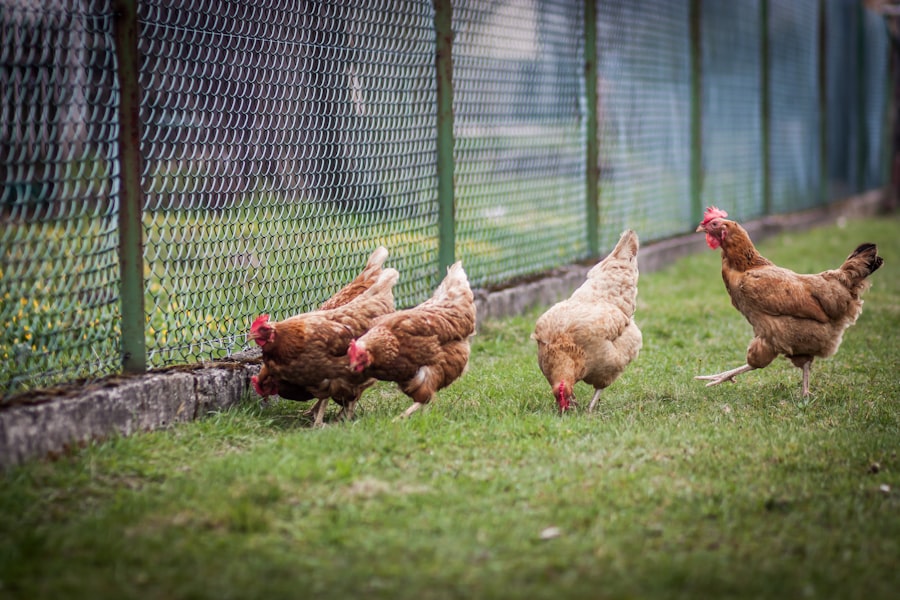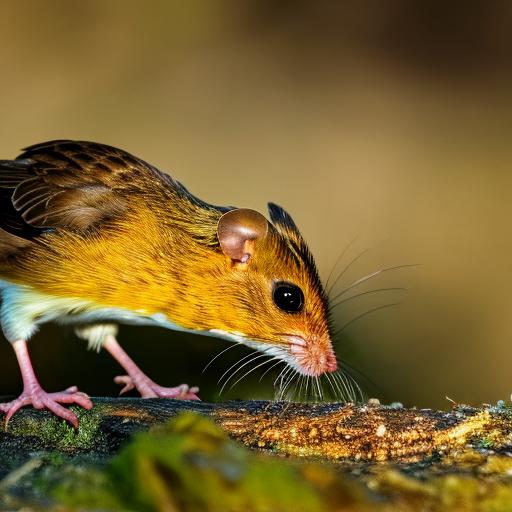Rats and chickens are two creatures that often find themselves coexisting in the same environment. While chickens are a popular choice for backyard farming and provide fresh eggs and meat, they can also attract unwanted attention from rats. Rats are drawn to chicken coops because of the readily available food source and shelter they provide. However, it is important to keep chickens safe from rats, as these rodents can pose a threat to the health and well-being of both the chickens and their owners.
Key Takeaways
- Rats and chickens can coexist, but it requires proper management to prevent infestations.
- Rats are attracted to chicken coops because of the food and shelter they provide.
- Factors like poor sanitation and inadequate coop design can contribute to rat infestations.
- Rats in a chicken coop can pose health risks to both the chickens and humans.
- Signs of rat infestations include droppings, gnaw marks, and missing eggs or chicks.
Understanding Rat Behavior
Rats are highly adaptable creatures that are known for their intelligence and ability to survive in various environments. They are attracted to chicken coops because of the abundance of food and shelter they offer. Rats are omnivorous and will eat almost anything, including chicken feed, eggs, and even young chicks. They are also excellent climbers and can easily access chicken coops through small openings or by scaling walls and fences.
Rats are primarily nocturnal creatures, which means they are most active during the night. This makes it difficult for chicken owners to detect their presence until a significant infestation has occurred. Rats are also known to reproduce rapidly, with a female rat capable of producing up to 12 litters per year, each containing 6-12 pups. This means that a small rat problem can quickly escalate into a full-blown infestation if not addressed promptly.
Factors Contributing to Rat Infestations
There are several factors that contribute to rat infestations in chicken coops. One of the main factors is the availability of food. Chicken feed is a primary food source for rats, and if it is left out in the open or stored improperly, it can attract these rodents. Additionally, rats are attracted to the smell of chicken droppings, which contain undigested grains that serve as a food source for them.
Another factor that contributes to rat infestations is the presence of shelter. Chicken coops provide rats with a warm and secure place to nest and breed. Rats can easily access chicken coops through small openings or by burrowing under fences. Once inside, they can hide in the nooks and crannies of the coop, making it difficult for chicken owners to detect their presence.
Risks and Dangers of Rats in Chicken Coops
Having rats in a chicken coop environment poses several risks and dangers. Firstly, rats can transmit diseases to both chickens and humans. They are known carriers of various diseases such as salmonella, leptospirosis, and hantavirus. These diseases can be transmitted through direct contact with rats or their droppings, urine, or saliva.
Rats also pose a threat to the health and well-being of chickens. They can attack and kill young chicks, as well as steal eggs from nesting boxes. Rats are also known to bite chickens, causing injuries that can become infected. Additionally, the presence of rats can cause stress and anxiety in chickens, leading to a decrease in egg production and overall health.
Signs of Rat Infestations in Chicken Coops
It is important for chicken owners to be able to identify the signs of rat infestations in their coops. Some common signs include:
1. Droppings: Rat droppings are small, dark pellets that resemble grains of rice. They are often found near food sources or along rat runways.
2. Gnaw marks: Rats have a constant need to gnaw on objects to keep their teeth sharp. Look for gnaw marks on chicken feed containers, nesting boxes, and other wooden structures in the coop.
3. Nests: Rats build nests using materials such as straw, feathers, and shredded paper. Look for nests in hidden areas of the coop, such as behind walls or under flooring.
4. Footprints: Rats leave footprints in dusty or muddy areas. Look for small, four-toed footprints near food sources or along rat runways.
Prevention Measures

Preventing rats from infesting your chicken coop is essential for the health and safety of your chickens. Here are some prevention measures you can take to keep rats away:
1. Secure the coop: Inspect the coop for any openings or gaps that rats could use to gain entry. Seal these openings with wire mesh or hardware cloth to prevent rats from getting in.
2. Store feed properly: Keep chicken feed in metal containers with tight-fitting lids to prevent rats from accessing it. Avoid leaving feed out overnight, as this can attract rats.
3. Clean up spilled feed: Regularly clean up any spilled feed in and around the coop. Rats are attracted to the smell of food, so keeping the area clean and free of debris will make it less attractive to them.
4. Remove hiding places: Clear away any clutter or debris around the coop that could provide hiding places for rats. Trim back vegetation and remove any piles of wood or other materials that rats could use as shelter.
Safe and Effective Rat Control
If you already have a rat infestation in your chicken coop, it is important to take steps to control their population. Here are some safe and effective methods for rat control:
1. Traps: Snap traps and live traps can be used to catch and remove rats from the coop. Place traps along rat runways or near food sources, and check them regularly.
2. Bait stations: Bait stations can be used to attract rats and poison them. However, caution must be exercised when using poison, as it can also harm chickens and other animals if ingested.
3. Natural deterrents: Some natural deterrents, such as peppermint oil or ammonia-soaked rags, can help repel rats from the coop. Place these deterrents in areas where rats are likely to enter or hide.
4. Professional pest control: If the rat infestation is severe or persistent, it may be necessary to seek the help of a professional pest control company. They can assess the situation and provide safe and effective solutions for rat control.
Importance of Sanitation and Waste Management
Proper sanitation and waste management are crucial in preventing rat infestations in chicken coops. Rats are attracted to the smell of chicken droppings, which contain undigested grains that serve as a food source for them. By properly managing waste, you can reduce the likelihood of rats being attracted to your coop.
Regularly clean out the coop and remove any soiled bedding or droppings. Dispose of these materials in a sealed container or compost pile away from the coop. Avoid leaving chicken waste exposed, as this can attract rats and other pests.
Tips for Maintaining a Clean and Rat-Free Chicken Coop
Maintaining a clean and rat-free chicken coop requires regular upkeep and attention. Here are some tips to help you keep your coop clean and tidy:
1. Clean regularly: Regularly clean out the coop, removing any soiled bedding or droppings. This will help prevent the buildup of odors and attractants that can attract rats.
2. Use rodent-proof materials: When building or renovating your coop, use materials that are resistant to gnawing and chewing. Metal or concrete flooring, wire mesh walls, and solid doors can help prevent rats from gaining entry.
3. Install predator deterrents: Installing predator deterrents such as motion-activated lights or sound devices can help deter rats from approaching the coop.
4. Practice good hygiene: Wash your hands thoroughly after handling chickens or cleaning the coop to prevent the spread of diseases. Keep feed and water containers clean and free of debris.
In conclusion, keeping chickens safe from rats is essential for the health and well-being of both the chickens and their owners. Rats are attracted to chicken coops because of the readily available food source and shelter they provide. However, rats can pose several risks and dangers to chickens, including the transmission of diseases and the theft of eggs. By understanding rat behavior, implementing prevention measures, and practicing proper sanitation and waste management, chicken owners can maintain a clean and rat-free coop environment.
If you’re considering keeping chickens, it’s important to be aware of the potential risks and challenges that come with it. One such concern is the attraction of rats. According to a related article on Poultry Wizard, having chickens can inadvertently invite rats into your backyard. These rodents are attracted to the food and shelter provided by chicken coops, making it crucial to take preventive measures. To learn more about how to keep your chickens safe from rat infestations, check out this informative article on Poultry Wizard.
FAQs
What is the connection between keeping chickens and attracting rats?
Keeping chickens can attract rats because they are a source of food for them. Rats are attracted to chicken feed, eggs, and even the chickens themselves.
How can I prevent rats from being attracted to my chicken coop?
To prevent rats from being attracted to your chicken coop, make sure to store chicken feed in a secure container that rats cannot access. Keep the coop clean and free of any food scraps or spilled feed. Also, make sure to seal any holes or gaps in the coop that rats could use to enter.
Are there any other animals that may be attracted to a chicken coop?
Yes, other animals such as raccoons, opossums, and even foxes may be attracted to a chicken coop. It is important to take measures to protect your chickens from these predators as well.
Can rats pose a danger to my chickens?
Yes, rats can pose a danger to chickens. They may attack and kill chickens, especially young or weak ones. Rats can also spread diseases to chickens, which can lead to illness or death.
What are some signs that rats may be present in my chicken coop?
Some signs that rats may be present in your chicken coop include droppings, gnaw marks on feed containers or coop walls, and sightings of rats themselves. You may also notice that chicken feed is disappearing quickly or that eggs are being eaten.
Meet Walter, the feathered-friend fanatic of Florida! Nestled in the sunshine state, Walter struts through life with his feathered companions, clucking his way to happiness. With a coop that’s fancier than a five-star hotel, he’s the Don Juan of the chicken world. When he’s not teaching his hens to do the cha-cha, you’ll find him in a heated debate with his prized rooster, Sir Clucks-a-Lot. Walter’s poultry passion is no yolk; he’s the sunny-side-up guy you never knew you needed in your flock of friends!







